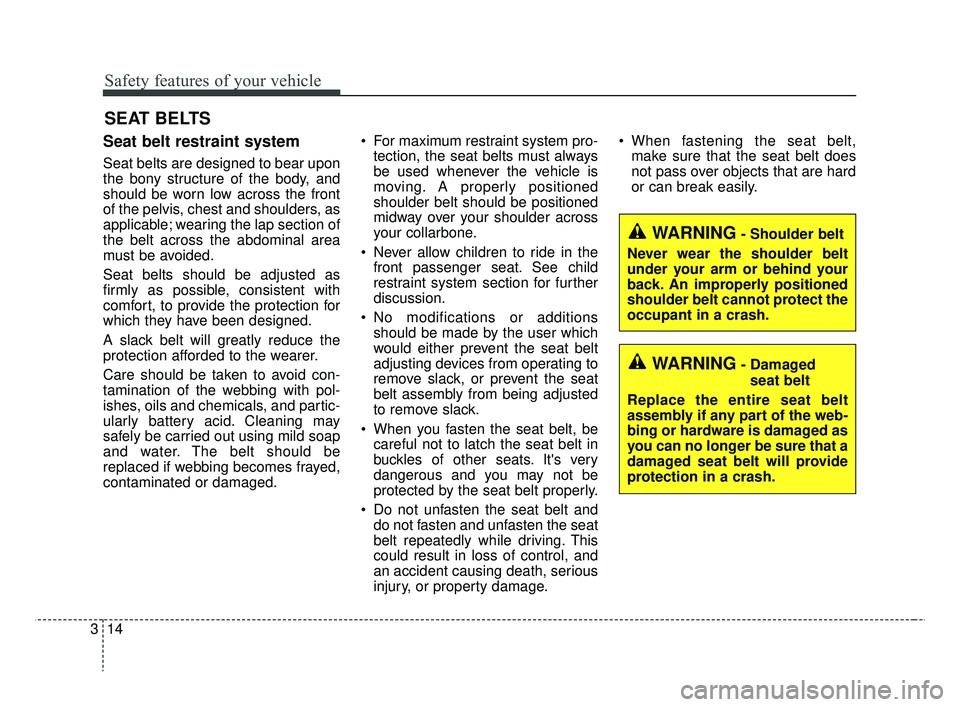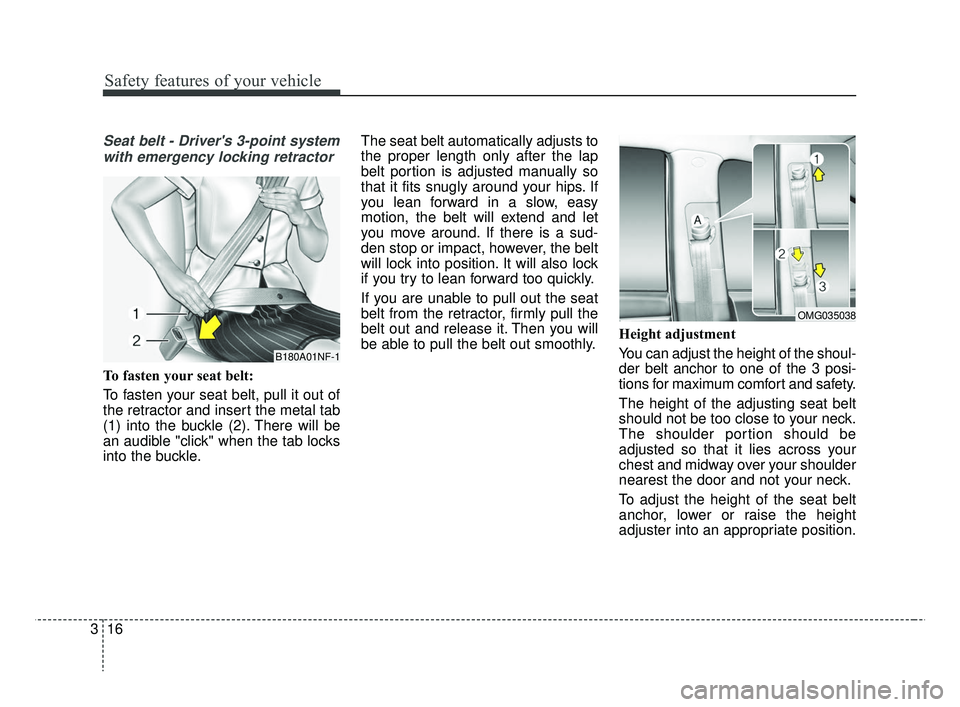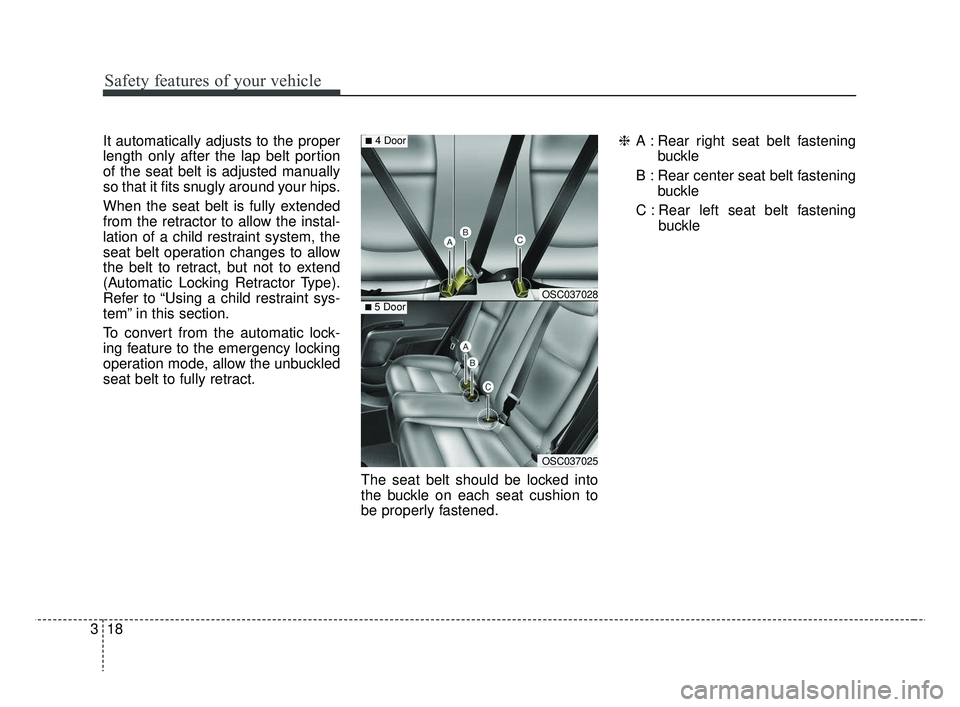2019 KIA RIO system
[x] Cancel search: systemPage 18 of 503

Safety features of your vehicle
Seat. . . . . . . . . . . . . . . . . . . . . . . . . . . . . . . . . . . . \
. . . 3-2
• Driver’s seat . . . . . . . . . . . . . . . . . . . . . . . . . . . . . . . . . . 3-2
• Front passenger’s seat. . . . . . . . . . . . . . . . . . . . . . . . . . 3-2
• Rear seat . . . . . . . . . . . . . . . . . . . . . . . . . . . . . . . . . . . . \
. 3-2
• Front seat adjustment . . . . . . . . . . . . . . . . . . . . . . . . . . 3-5
• Headrest (for front seat) . . . . . . . . . . . . . . . . . . . . . . . . 3-6
• Seatback pocket . . . . . . . . . . . . . . . . . . . . . . . . . . . . . . . 3-9
• Rear seat adjustment . . . . . . . . . . . . . . . . . . . . . . . . . . 3-9
Seat belts . . . . . . . . . . . . . . . . . . . . . . . . . . . . . . . . . 3-14
• Seat belt restraint system . . . . . . . . . . . . . . . . . . . . . . 3-14
• Pre-tensioner seat belt. . . . . . . . . . . . . . . . . . . . . . . . . 3-20
• Seat belt precautions . . . . . . . . . . . . . . . . . . . . . . . . . . 3-22
• Care of seat belts . . . . . . . . . . . . . . . . . . . . . . . . . . . . . 3-24
Child Restraint System (CRS) . . . . . . . . . . . . . . . 3-26
• Using a child restraint system . . . . . . . . . . . . . . . . . . 3-27
Air bag - advanced supplemental restraint system. 3-33
• How does the air bag system operate . . . . . . . . . . . . 3-34
• Air bag warning light . . . . . . . . . . . . . . . . . . . . . . . . . 3-37
• SRS components and functions . . . . . . . . . . . . . . . . . 3-37
• Occupant detection system . . . . . . . . . . . . . . . . . . . . . 3-40
• Driver's and passenger's front air bag . . . . . . . . . . . 3-48
• Side air bag . . . . . . . . . . . . . . . . . . . . . . . . . . . . . . . . . 3-51
• Curtain air bag . . . . . . . . . . . . . . . . . . . . . . . . . . . . . . 3-53 • Inflation and non-inflation conditions of
the air bag. 3-55
• SRS Care . . . . . . . . . . . . . . . . . . . . . . . . . . . . . . . . . . . 3-\
60
• Adding equipment to or modifying your air bag-equipped vehicle. . . . . . . . . . . . . . . . . . . . . . 3-61
• Air bag warning label . . . . . . . . . . . . . . . . . . . . . . . . . 3-61
3
SC CAN (ENG) 3.QXP 7/18/2018 5:54 PM Page 1
Page 20 of 503

33
Safety features of your vehicle
WARNING - Uprightingseat
Do not press the release lever
on a manual seatback without
holding and controlling the
seatback. The seatback will
spring upright possibly impact-
ing you or other passengers.
WARNING- Loose objects
Do not place anything in the dri-
ver's foot well or under the front
seats. Loose objects in the dri-
ver's foot area could interfere with
the operation of the foot pedals.WARNING
- Driver responsibility for passengers
The driver must advise the pas-
senger to keep the seatback in
an upright position whenever
the vehicle is in motion. If a seat
is reclined during an accident,
the restraint system's ability to
restrain will be greatly reduced.
1KMN3661
WARNING - Seat cushion
Occupants should never sit on
aftermarket seat cushions or sit-
ting cushions. The passenger's
hips may slide under the lap por-
tion of the seat belt during an
accident or a sudden stop.
WARNING- Driver’s seat
Never attempt to adjust the seat while the vehicle is mov-
ing. This could result in loss
of control of your vehicle.
Do not allow anything to inter- fere with the normal position
of the seatback and seatback
adjustment.
Sit as far back as possible from the steering wheel while
still maintaining comfortable
control of your vehicle. A dis-
tance of at least 25 cm (10 in)
from your chest to the steer-
ing wheel is recommended.
Failure to do so could result in
air bag inflation injuries to the
driver.
SC CAN (ENG) 3.QXP 7/18/2018 5:54 PM Page 3
Page 26 of 503

39
Safety features of your vehicle
Seatback pocket
The seatback pocket is provided on
the back of the front passenger’s
seatback.
Rear seat adjustment
Headrest (for rear seat)
The rear seat is equipped with head-
rests in left and right side seating
positions for the occupant's safety
and comfort.
The headrest not only provides com-
fort for passengers, but also helps
protect the head and neck in the
event of a collision.For maximum effectiveness in case
of an accident, the headrest should
be adjusted so the middle of the
headrest is at the same height of the
center of gravity of an occupant's
head. Generally, the center of gravity
of most people's head is similar with
the height as the top of their eyes.
Also adjust the headrest as close to
your head as possible. For this rea-
son, the use of a cushion that holds
the body away from the seatback is
not recommended.
WARNING- Seatback
pocket
Do not put heavy or sharp
objects in the seatback pocket.
An occupant could contact such
objects in a crash. Heavy
objects in the front passenger
seatback could also interfere
with the air bag sensing system.
OYB036010
OSC037015N
SC CAN (ENG) 3.QXP 7/18/2018 5:55 PM Page 9
Page 31 of 503

Safety features of your vehicle
14
3
Seat belt restraint system
Seat belts are designed to bear upon
the bony structure of the body, and
should be worn low across the front
of the pelvis, chest and shoulders, as
applicable; wearing the lap section of
the belt across the abdominal area
must be avoided.
Seat belts should be adjusted as
firmly as possible, consistent with
comfort, to provide the protection for
which they have been designed.
A slack belt will greatly reduce the
protection afforded to the wearer.
Care should be taken to avoid con-
tamination of the webbing with pol-
ishes, oils and chemicals, and partic-
ularly battery acid. Cleaning may
safely be carried out using mild soap
and water. The belt should be
replaced if webbing becomes frayed,
contaminated or damaged. For maximum restraint system pro-
tection, the seat belts must always
be used whenever the vehicle is
moving. A properly positioned
shoulder belt should be positioned
midway over your shoulder across
your collarbone.
Never allow children to ride in the front passenger seat. See child
restraint system section for further
discussion.
No modifications or additions should be made by the user which
would either prevent the seat belt
adjusting devices from operating to
remove slack, or prevent the seat
belt assembly from being adjusted
to remove slack.
When you fasten the seat belt, be careful not to latch the seat belt in
buckles of other seats. It's very
dangerous and you may not be
protected by the seat belt properly.
Do not unfasten the seat belt and do not fasten and unfasten the seat
belt repeatedly while driving. This
could result in loss of control, and
an accident causing death, serious
injury, or property damage. When fastening the seat belt,
make sure that the seat belt does
not pass over objects that are hard
or can break easily.
SEAT BELTS
WARNING- Shoulder belt
Never wear the shoulder belt
under your arm or behind your
back. An improperly positioned
shoulder belt cannot protect the
occupant in a crash.
WARNING- Damaged seat belt
Replace the entire seat belt
assembly if any part of the web-
bing or hardware is damaged as
you can no longer be sure that a
damaged seat belt will provide
protection in a crash.
SC CAN (ENG) 3.QXP 7/18/2018 5:55 PM Page 14
Page 33 of 503

Safety features of your vehicle
16
3
Seat belt - Driver's 3-point system
with emergency locking retractor
To fasten your seat belt:
To fasten your seat belt, pull it out of
the retractor and insert the metal tab
(1) into the buckle (2). There will be
an audible "click" when the tab locks
into the buckle. The seat belt automatically adjusts to
the proper length only after the lap
belt portion is adjusted manually so
that it fits snugly around your hips. If
you lean forward in a slow, easy
motion, the belt will extend and let
you move around. If there is a sud-
den stop or impact, however, the belt
will lock into position. It will also lock
if you try to lean forward too quickly.
If you are unable to pull out the seat
belt from the retractor, firmly pull the
belt out and release it. Then you will
be able to pull the belt out smoothly.
Height adjustment
You can adjust the height of the shoul-
der belt anchor to one of the 3 posi-
tions for maximum comfort and safety.
The height of the adjusting seat belt
should not be too close to your neck.
The shoulder portion should be
adjusted so that it lies across your
chest and midway over your shoulder
nearest the door and not your neck.
To adjust the height of the seat belt
anchor, lower or raise the height
adjuster into an appropriate position.
B180A01NF-1
OMG035038
SC CAN (ENG) 3.QXP 7/18/2018 5:55 PM Page 16
Page 34 of 503

317
Safety features of your vehicle
To raise the height adjuster, pull it up
(1). To lower it, push it down (3) while
pressing the height adjuster button (2).
Release the button to lock the anchor
into position. Try sliding the height
adjuster to make sure that it has
locked into position. Never position the
shoulder belt across your neck or face.
Improperly positioned seat belts can
cause serious injuries in an accident.Seat belts - Front passenger andrear seat 3-point system withcombination locking retractor
To fasten your seat belt
Combination retractor type seat belts
are installed in the rear seat posi-
tions to help accommodate the
installation of child restraint systems.
Although a combination retractor is
also installed in the front passenger
seat position, it is strongly recom-
mended that children always be
seated in the rear seat. NEVER
place an infant restraint system in
the front seat of the vehicle.
This type of seat belt combines the
features of both an emergency lock-
ing retractor seat belt and an auto-
matic locking retractor seat belt. To
fasten your seat belt, pull it out of the
retractor and insert the metal tab into
the buckle. There will be an audible
"click" when the tab locks into the
buckle. When not securing a child
restraint, the seat belt operates in the
same way as the driver's seat belt
(Emergency Locking Retractor Type).
WARNING- Seat belt replacement
Replace your seat belts after
being in an accident. Failure to
replace seat belts after an acci-
dent could leave you with dam-
aged seat belts that will not pro-
vide protection in the event of
another collision.
WARNING- Shoulder belt positioning
Never position the shoulder belt
across your neck or face.
B200A01NF
WARNING
You should place the lap belt
portion as low as possible and
snugly across your hips, not on
your waist. If the lap belt is locat-
ed too high on your waist, it may
increase the chance of injury in
the event of a collision. Both
arms should not be under or
over the belt. Rather, one should
be over and the other under, as
shown in the illustration.
Never wear the seat belt under
the arm near the door.
SC CAN (ENG) 3.QXP 7/18/2018 5:55 PM Page 17
Page 35 of 503

Safety features of your vehicle
18
3
It automatically adjusts to the proper
length only after the lap belt portion
of the seat belt is adjusted manually
so that it fits snugly around your hips.
When the seat belt is fully extended
from the retractor to allow the instal-
lation of a child restraint system, the
seat belt operation changes to allow
the belt to retract, but not to extend
(Automatic Locking Retractor Type).
Refer to “Using a child restraint sys-
tem” in this section.
To convert from the automatic lock-
ing feature to the emergency locking
operation mode, allow the unbuckled
seat belt to fully retract.
The seat belt should be locked into
the buckle on each seat cushion to
be properly fastened.❈
A : Rear right seat belt fastening
buckle
B : Rear center seat belt fastening buckle
C : Rear left seat belt fastening buckle
OSC037028
OSC037025
■5 Door
■4 Door
SC CAN (ENG) 3.QXP 7/18/2018 5:55 PM Page 18
Page 37 of 503

Safety features of your vehicle
20
3
Pre-tensioner seat belt
Your vehicle is equipped with driver's
and front passenger's pre-tensioner
seat belts. 1. Retractor pre-tensioner
The retractor pre-tensioner is a sup-
plemental system of the seat belts.
The purpose of the retractor pre-ten-
sioner is to tighten the shoulder belt
against the occupant's upper body in
certain frontal collisions.
The pre-tensioner seat belts may be
activated, when a collision is severe
enough, together with the air bags.
When the vehicle stops suddenly, or
if the occupant tries to lean forward
too quickly, the seat belt retractor
may lock into position. In certain
frontal collisions (or side collisions),
the pre-tensioner may activate and
pull the seat belt into tighter contact
against the occupant's body.
If the system senses excessive ten-
sion on the driver or passenger's seat
belt when the pre-tensioner activates,
the load limiter inside the retractor
pre-tensioner will release some of the
pressure on the affected seat belt.2. Emergency Fastening Device
(EFD)
The Emergency Fastening Device
(EFD) is a supplemental system of
the seat belts. The purpose of the
EFD is to tighten the lap belt against
the occupant's pelvis in certain colli-
sions.
OXMA033101
SC CAN (ENG) 3.QXP 7/18/2018 5:56 PM Page 20